It’s been a long while since I wrote up a terrain project, mostly because I have a couple stuck in half completed limbo. But one is moving forward; I finished construction this weekend, and expect to have it painted up for my local shop’s next RECON+ Infinity tournament: The Derelict Depot.
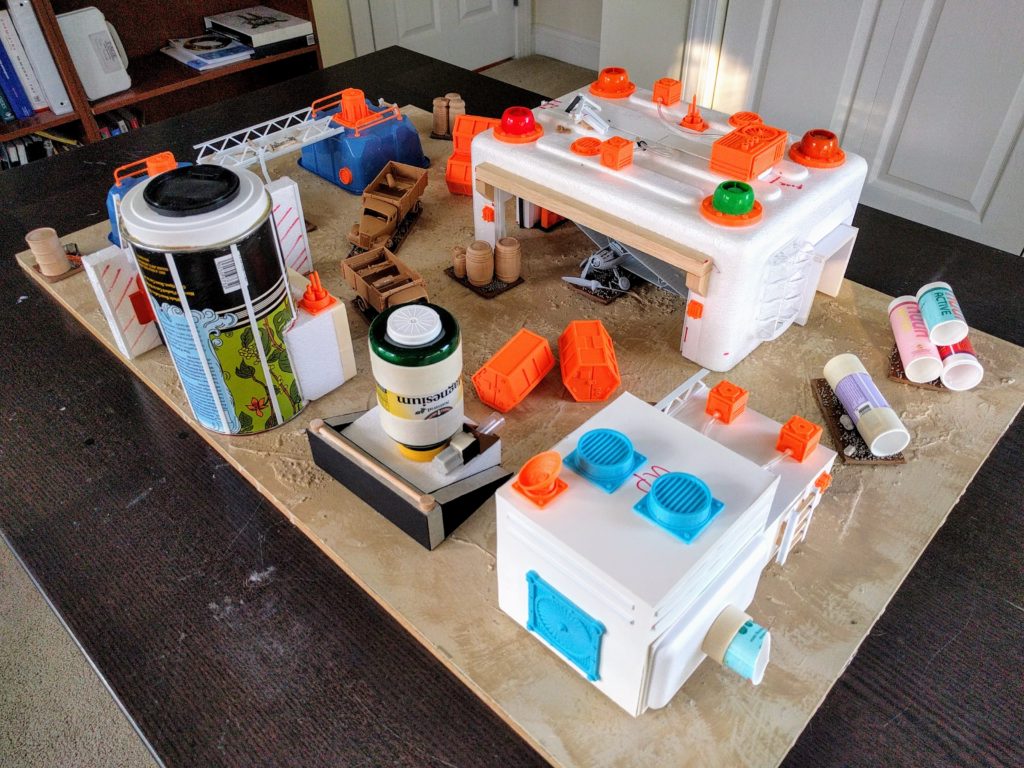
Construction complete!
Planning
RECON+ is basically half the size of a standard Infinity match: 150 points, on a roughly 24″ by 36″ board. I really like the format and we play it often so I wanted to put a new, detailed board into the rotation. Major goals were that it work for Infinity, which has fairly different terrain considerations from 40k, and that it not look or play like the “MDF-box” cities that are somewhat ubiquitous in Infinity. I think the end result will fit right in with the Shantytown, Old City/Slums, and other unique terrain we run at the shop alongside the more standard MDF stuff.
The start was an actual, physical board I’ve had kicking around almost a decade now after I made some basic terrain for teaching 40k to the university gaming club. The desert colors brought to mind a scenery idea I’ve dreamed about for some time but not built yet: A vehicle graveyard. Simultaneously, some interesting packaging scraps laying around got me thinking about a fuel depot or similar. Putting the two ideas together I started building toward an abandoned vehicle depot.
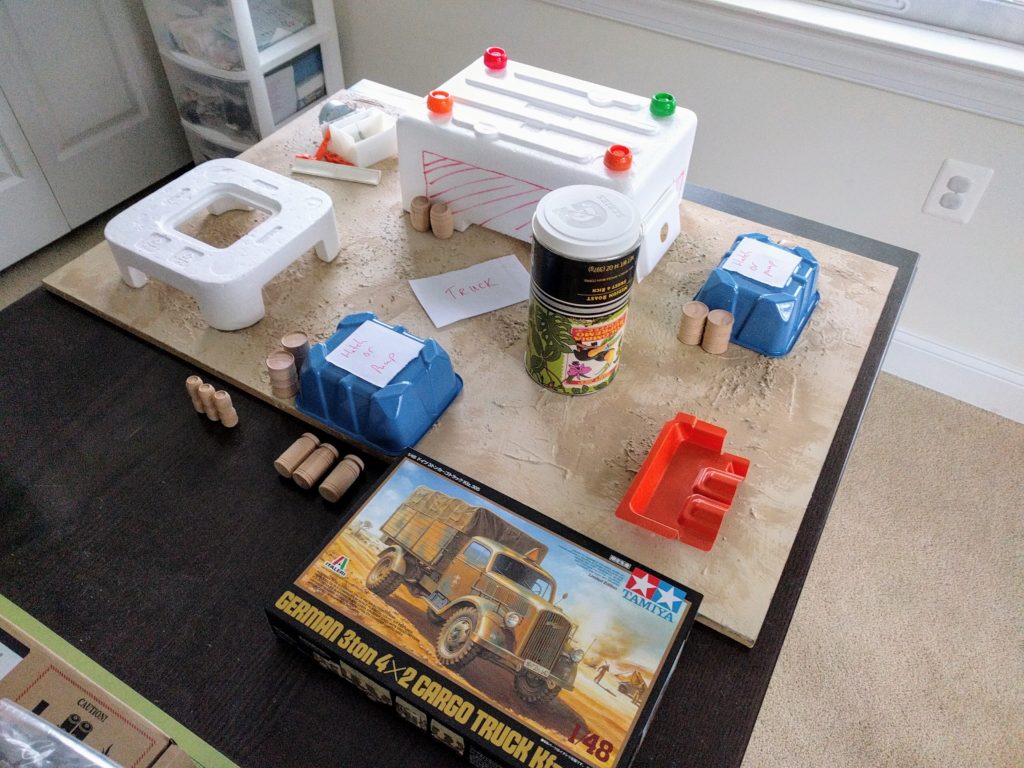
Very very preliminary ideas.
Garage
I quickly settled on the defining piece being a garage of sorts. Our Infinity group doesn’t play many interiors so I thought it’d be neat to force some inside action. I liked the image of two teams shooting it out across a garage while huddling behind small humanoid doorways on the sides. Cutting big vehicle doorways on both sides to make it a pass-through garage was a simple way to make the interior playable. You can fairly easily move figures around inside through the large openings on either side.

Sketching out cuts on the garage.
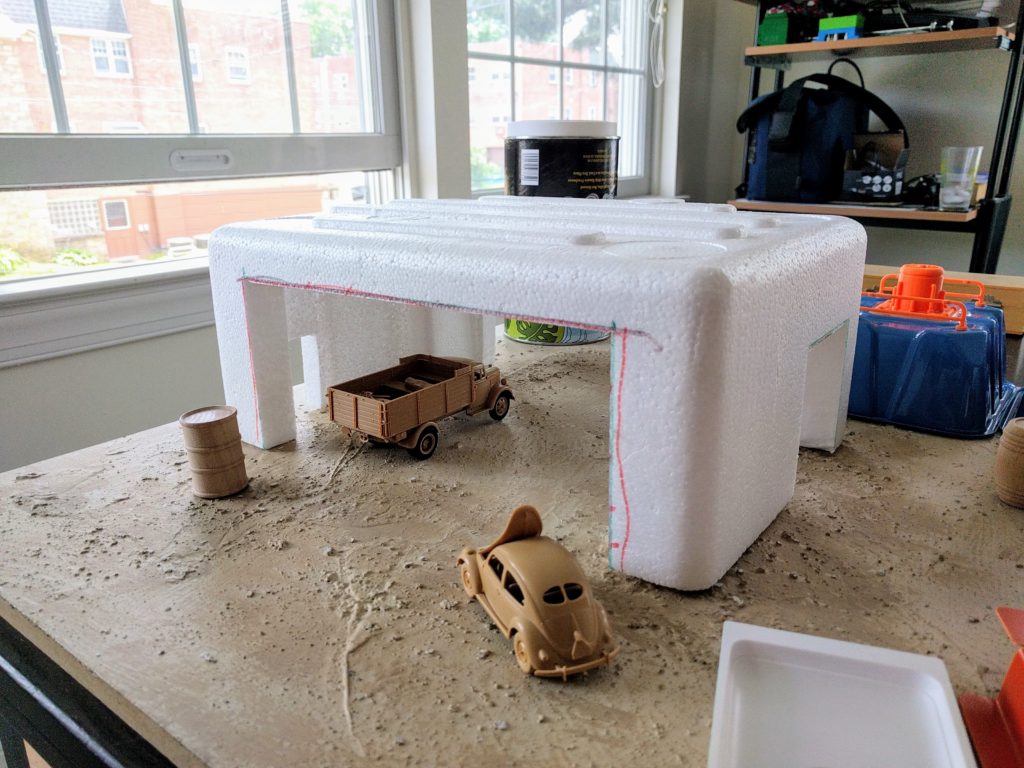
Initial cuts forming the garage.
One quirk about nearly all Infinity “MDF-box” terrain is the little walls on the tops of the buildings, sides of walkways, and so on. They provide obvious, extensive cover opportunities and straightforward gameplay. But it’s a little weird that nearly every little roof and walkway has short solid walls. Most roofs I’ve been on you can just walk off, most walkways have railings, fences are more common than walls, etc..
So rather than put unnatural little walls all around the roof of the garage, I put a bunch of large-ish features that an infantry model could get partial cover behind while prone models could easily duck below and move around safely provided they watch their angles. The turbine ventilation units are stolen off baby food pouches, while the other brightly colored bits here and throughout this board are 3d printed pieces I designed for this kind of assisted scratchbuilding. For this construction I had to rely on pieces I had laying around already as my printer is currently fully occupied churning out another project. Many of them are already available via my Thingiverse profile.
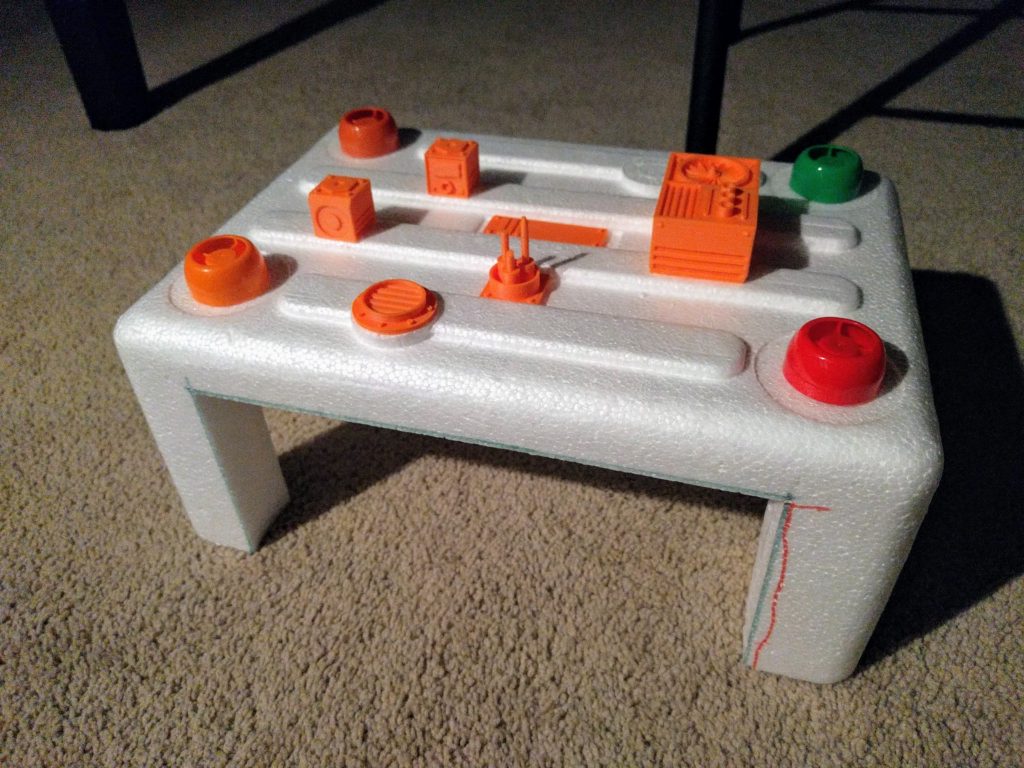
Testing details on the roof to provide some cover.
With the basic openings and roof features selected, I spent a while adding trim and details, just whatever I could think of and had on hand or could create quickly. Just one side got a ladder, in keeping with the idea that Infinity boards shouldn’t be that symmetric, built using a technique I use often. Both sides got outcroppings to provide some cover along their faces. The roof got an additional pile of junk “metal” to make a small cover nest, and some tubing hooked up between the mechanical boxes for flair.

“Front” of the garage (the front and back faces are essentially the same).

Side of the garage.
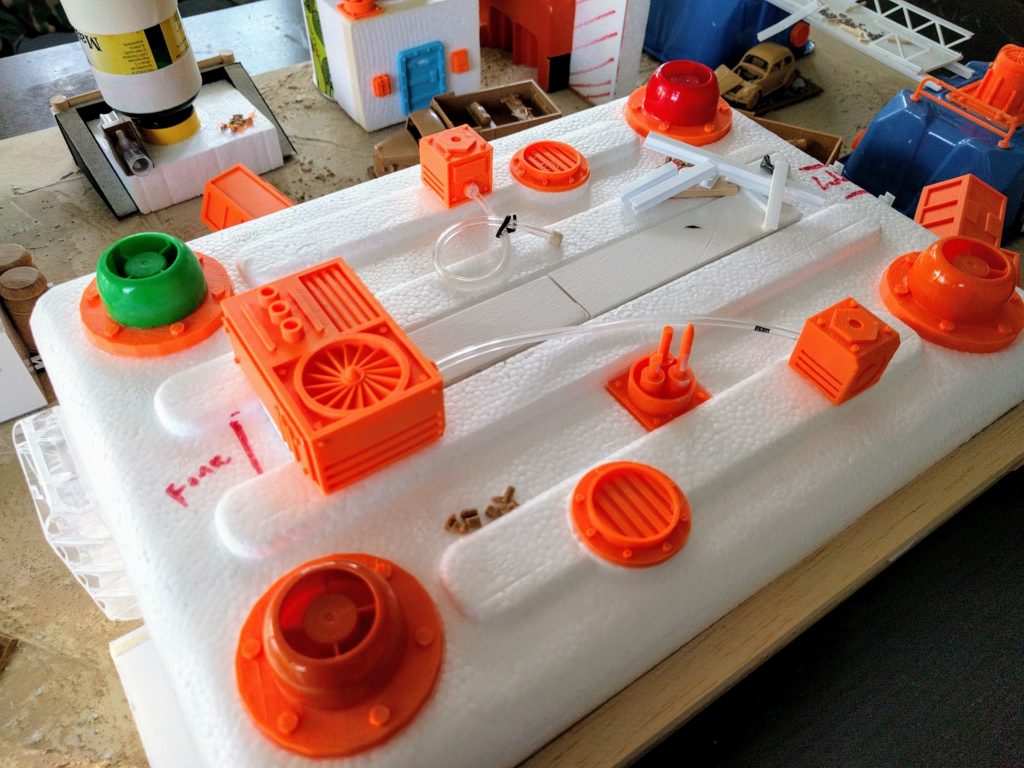
Final rooftop details of the garage.
Fuel Reservoirs
Next up were some fuel reservoirs made of supermarket mushroom containers. The key feature here is some kind of large pump that I imagined keeping the fuel moving around and cooled, or a giant fan for ventilation. These are big enough to provide cover, but I also added some railings on the sides. By themselves these are too slight to reasonably obscure any models enough for protection. However, once painted I plan to add overgrowth all across the board to give it an abandoned, unmaintained feel. Vines and plants draped over these railings will solidify them visually and make it clear that they provide cover, without having just stuck on some solid walls.

Primary components on the fuel reservoirs.
To create some vertically overlapped space on the board, a distinctive feature of much Infinity terrain, I made a walkway out of polystyrene strips and sheeting to go between the fuel reservoirs. The garage I think is too big for it to really feel like two planes of combat despite having two levels; the roof and interior can’t interact enough. Sizing for the walkway is dictated by having just enough clearance for a 40mm base to definitely fit on it. Overgrowth will provide models some cover while crossing, but mostly only from one direction—one side has already been blasted away! I frequently lose a trooper or two to missile and rocket fire while hiding on walkways by my deployment zone, and I wanted to capture that kind of story vignette here.
Finally, each fuel reservoir got a ladder, and some lights and vents were tacked on. Unusually for my terrain there’s no functional hint, no obvious interface for actually getting fuel in & out of the reservoirs. But I thought they looked fine at this point, I wanted to move on, and that lack of grounding is certainly not out of place in miniatures gaming. Maybe these entire buildings are cooling circulation units for a huge underground reservoir, interfaced through the pipes and fittings on the other pieces?
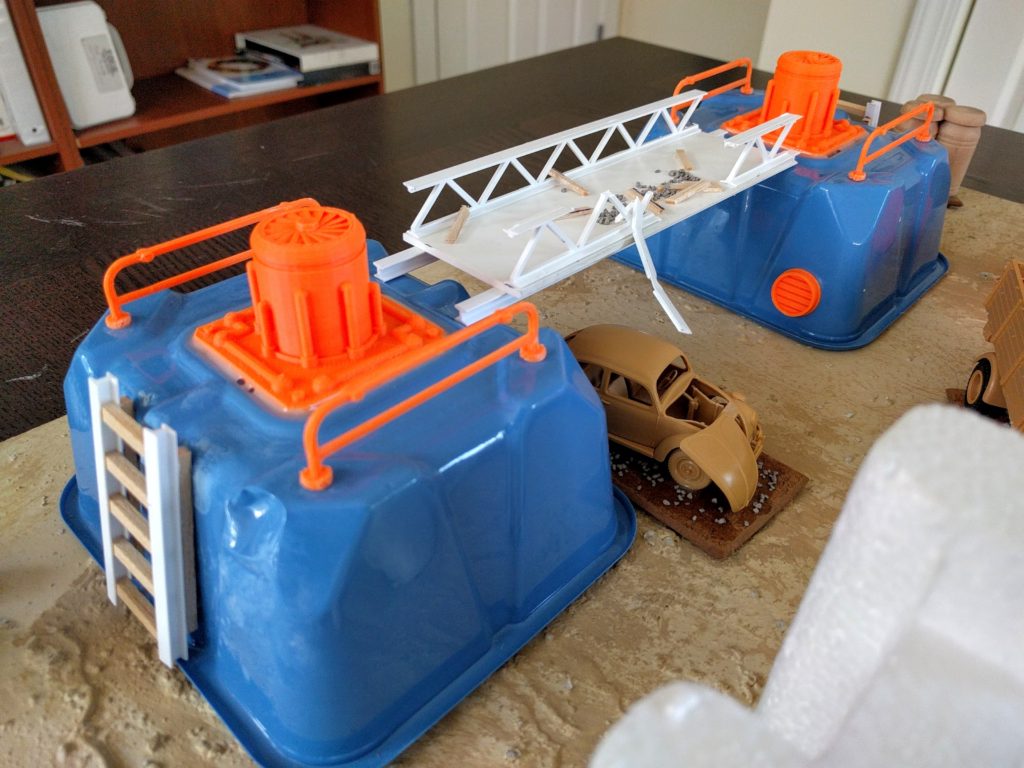
Ladder and walkway.
The mushroom containers are unfortunately very thin and compress too easily, the main effect of which is the features could pop off due to the plastic flexing under them. I’m going to address that by filling the undersides with expanding hard foam.
With the core concepts of the garage and fuel reservoirs nailed down, everything kind of took off. After almost a month of sitting on my hobby table getting poked at every now and then, the rest of the board got built pretty quickly over a couple nights. To those three pieces I added a mechanical building, silo, liquid tank, and a segment of blast wall to provide some additional large elements blocking line of sight. A variety of vehicles, containers, and scrap pipes then filled out the board with scatter terrain.
Mechanical Building
The mechanical building was inspired by realizing some sports drink canisters I had fit perfectly over the hole in a piece of plastic electronics packaging that I wanted to put on a wall somewhere. I started thinking it could be the broken output pipe from some giant pump. Later I realized this idea is a bit of a rehash, it basically combines the pump station and pipeworks pieces from my Medea Refinery build, but that’s ok.
Two blocks of foam covered entirely in cardstock make up the shape of the mechanical building. Again I used chunky details to provide cover rather than just solid walls. One railing is included though, which will get vines and ivy just like the fuel reservoirs to make it actual cover. As on the garage, I especially enjoy the tubing connecting some of the mechanical boxes to the wall inlets as a neat functional hint. The canisters on the front are glued on to break up the wall surface and provide cover straight down its length as the broken pipe does on the back. A short ladder at the back provides quick access the the mechanical boxes on the roof, but I purposefully did not add a second to the top roof so that it would take some extra climbing to get there.

Front of the mechanical building.
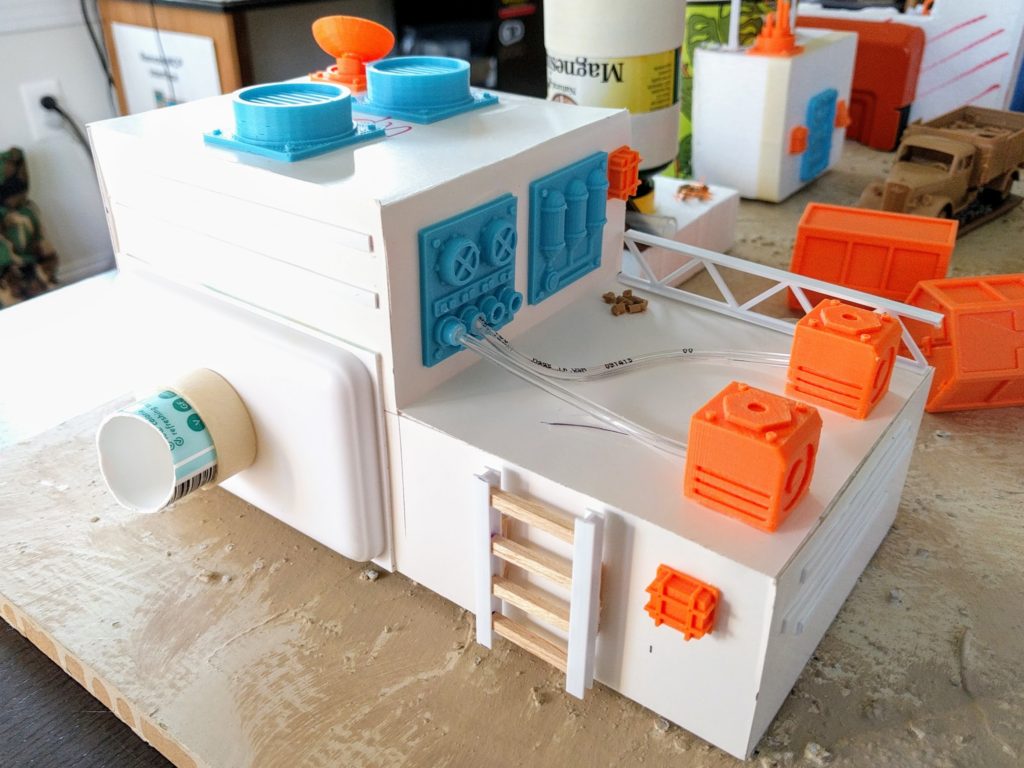
Back and roof of the mechanical building.
Silo and Tank
To create some more big LOS blockers, I made up a silo and a fuel tank out of coffee and vitamin containers. Loops of masking tape and polystyrene strips combined with the foundation pieces hopefully will break up the recognizability of the shapes just a bit once painted. I did not add ladders or platforms to the silo, though I might think about that some more so that any models on top are more accessible to close attack. Hopefully players will know to not place the tallest terrain piece in either deployment zone and let a model just deploy on top unreachably. I also plan to add a lot of built-up overgrowth to the top to make it difficult to place infiltrating snipers there.

Tank and silo (left and right).
Details
Finally, I made a whole bunch of scatter terrain: Several vehicles, lots of containers, and some piles of scrap pipes. The shipping containers are 3d printed designs I made that have been super useful on several boards. One variant is on Thingiverse. The other containers are wood pieces I got in bulk a while ago and use everywhere. The scrap pipes are sports drink tubes hacked up, and in one case wrapped with tape to make the ends look fitted. I like them being see-through laterally, making the ends tough to use for cover even as the sides are excellent for it.
The vehicles are 1/48 models. For 40k that works for some tanks and is arguably maybe “correct” if you incorrectly consider its miniatures to be 28mm scale models rather than the artistic, loose 28–32mm gaming pieces they are. But for these and most vehicles 1/48 is too small to look right in Warhammer. That’s one reason I never built my original vehicle graveyard idea. For Infinity though, as the figures are generally fairly accurately proportioned and mostly closer to 28mm scale, these models look ok. Next to heavy infantry or such they look small, but they should—those are big warriors in giant suits of armor! Compared to unarmoured troopers and similar the models look fairly plausible, particularly the earlier figures before Corvus Belli started creeping up the scale. Comparison pics to come once the terrain is painted.
I greatly enjoyed clipping and physically smashing down the really broken truck and airplane. I don’t know what kind of backstory justifies a biplane in an Infinity setting. Maybe this depot is on some neglected backwater planet and they use very low-tech vehicles for civilian tasks as they’re easy to build and maintain? I have no idea, but it looks pretty cool in the garage-hangar and is a neat piece of scatter terrain cover.
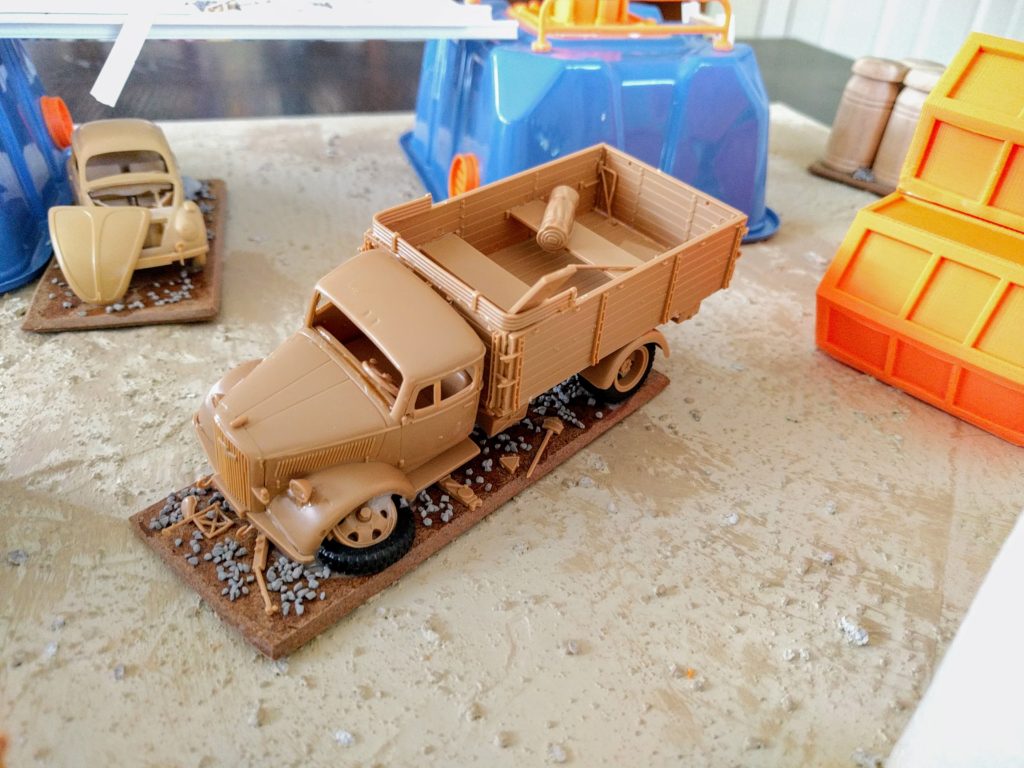
Broken down truck and Volkswagen. Original Volkswagen Beetles have their engines in the rear so that vignette with the hood off will be misread by a lot of people thinking it reflects working on the engine, but it’s still plausible.

Abandoned biplane in the garage.

Looking out from inside the garage.
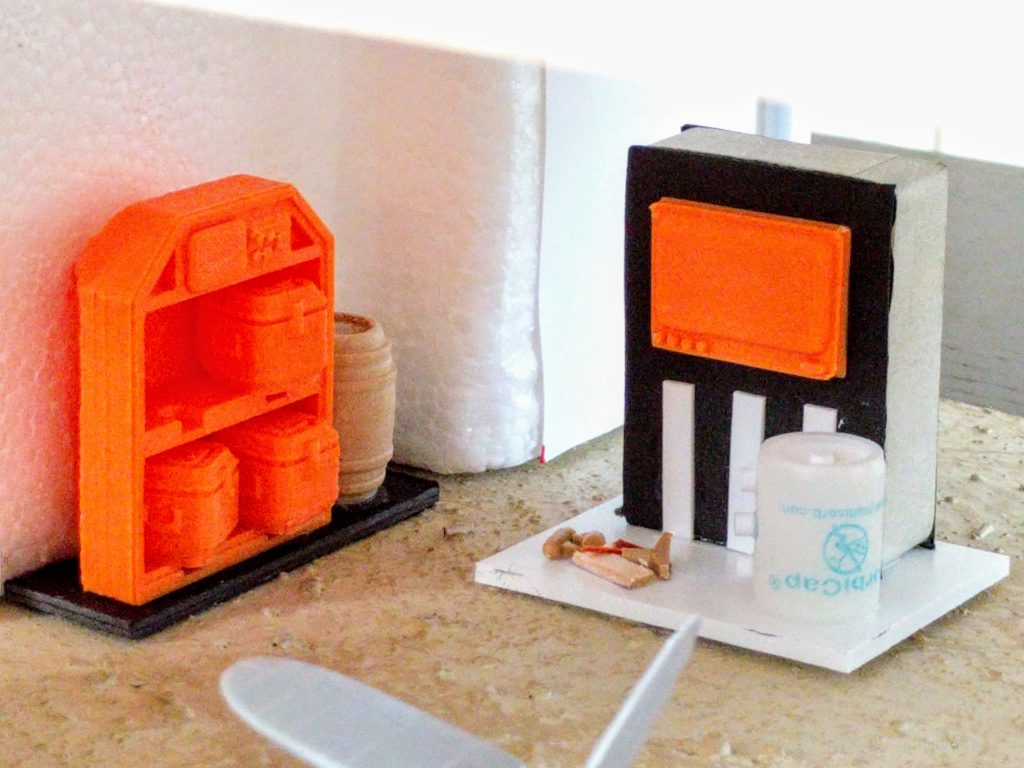
Diagnostics console, supplies shelves, and other equipment inside the garage.
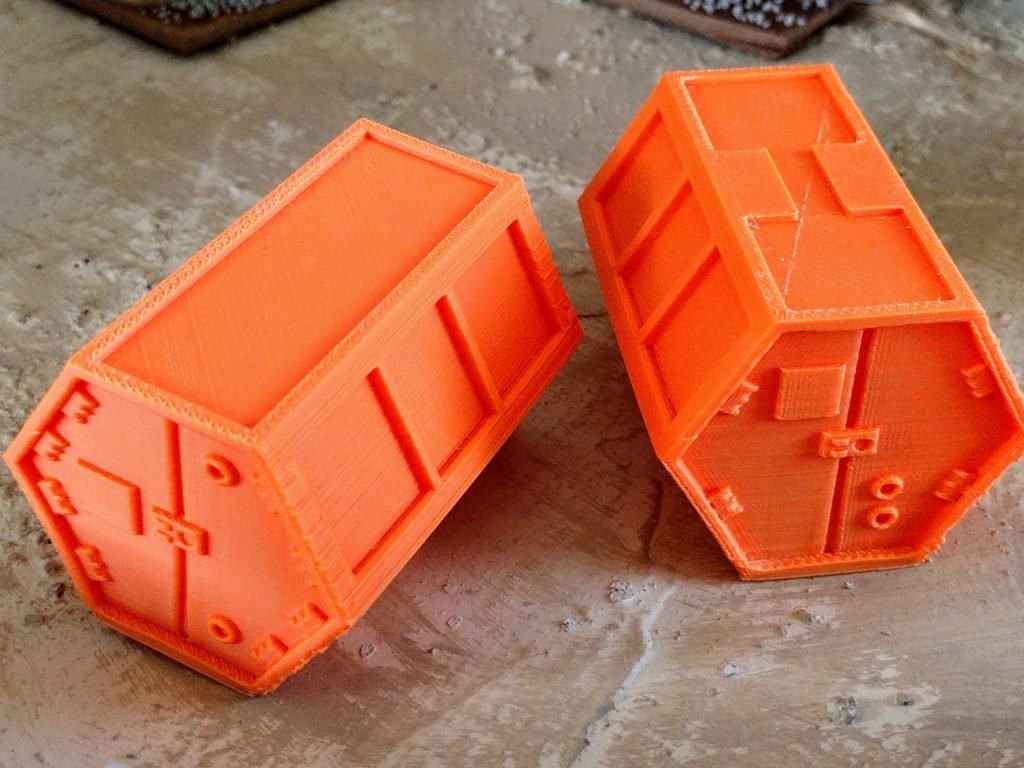
Shipping containers: The true hallmarks of far future war.
American-Style
That about wraps up the tour. There’s definitely enough pieces in the depot for the dense “American-style” boards we generally play in my Infinity scene, much to the sadness of my airborne troops. Big models have enough to hide behind, and there’s plenty of ways to prevent overly long firelanes and lots of partial cover over which to advance cautiously. Variety in heights should create good reasons to go up or slink around. Boards made with these pieces will definitely not be symmetric, an important property required to give meaning to the choice between initiative or deployment zone selection. On the flip side, the board is so dense that it should be difficult to inadvertently leave one side overly exposed. Finally, the pieces have a good level of detail, but easy playability and only a few features here and there that look particularly amenable to breaking, so I think it will hold up ok to public play.
Next up is painting, hopefully to be completed for next month’s tournament!
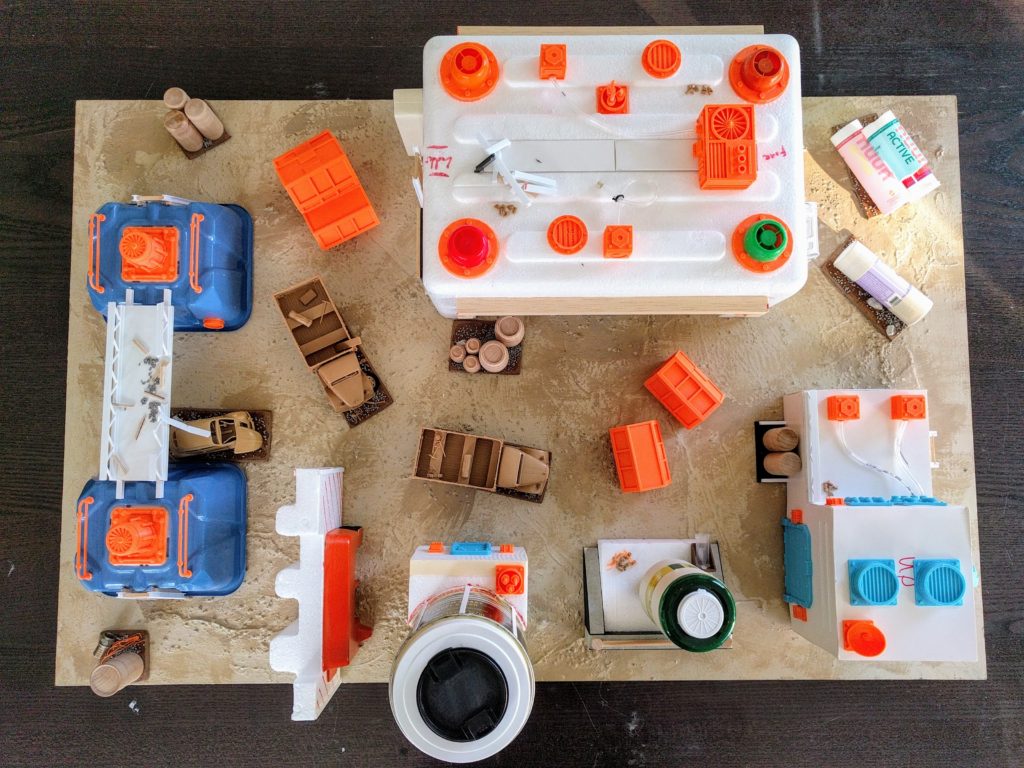
Top view.

Left airborne view.

Right airborne view.

Ground view left.

Ground view right.